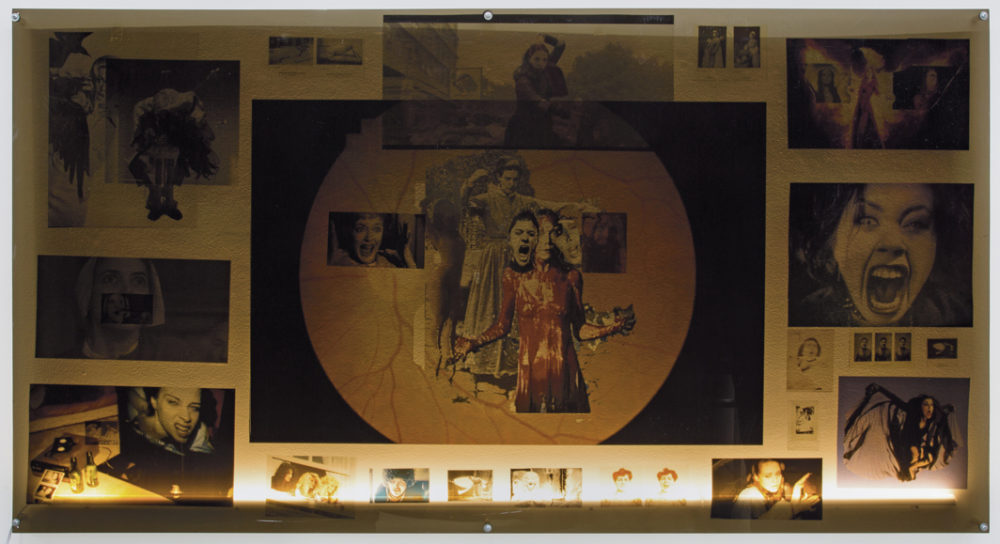
- Source: ARTFORUM
- Author: Jan Tumlir
- Date: January/February 2021
- Format: PRINT AND DIGITAL
Made in L.A. 2020
HAMMER MUSEUM

Kandis Williams, Pins and Needles, 2016, vinyl adhesive on Plexiglas, fluorescent light, 48 × 90.25 inches. From Made in L.A. 2020.
At the time of this writing, the fifth iteration of this city’s biennial, Made in L.A., a version, was closed to the public. Due to the pandemic, its official unveiling had been pushed off into an indeterminate future on government order, with just a few people allowed in at a time for a sneak peek. Under the circumstances, the haunted tone that pervaded the show by design was considerably augmented. In a Skype conversation transcribed for the biennial’s catalogue, curators Myriam Ben Salah and Lauren Mackler discuss the influence of horror films on their decision-making process. “Traditionally horror was used to evoke parallel realities or nonhuman experience,” muses Mackler. “Nowadays the idea is to accept a strangeness that is closer to us.” A more or less uncanny aspect could be made out in every work on view, and much of it certainly did have to do with the question of what it means to be human in this resolutely posthumanist and posthumanitarian century.
Horror, as an established genre, was sourced most directly through the inclusion of a full-scale haunted house, pieced together by writer Sabrina Tarasoff and a special-effects team. This structure might be a good place to start, for this work also highlighted a sense of historical ungrounding as a primary cause of our present malaise. A mainstream reimagining of the renegade Venice Beach institution Beyond Baroque—in its heyday of the 1980s a haven for poets and artists with a transgressive bent—Tarasoff’s work merged innocuous funfair artifice with documents and ephemera (xeroxed posters, taped literary readings, and performance videos) of a culture once devoted to plumbing the existential “hard core.” At once flip and deeply consequential, this crammed installation insistently summoned the temporal rift that threatens to engulf our moment. That the data with which we are increasingly deluged grows more vigorously on the historical back end than on the futuristic front was confirmed throughout the exhibition by works carrying the ghosts of the past as a punishing load.
Mathias Poledna’s short video Indifference, 2018, is a period piece that features a Wilhelmine soldier caught in a depressive pause during peacetime, dejectedly drinking at a café and smoking by a fountain. At the end of the piece, he simply collapses into his elaborate military costume while strolling along a garden path, the pile left behind a slapstick memento of a life overwhelmed by its myriad social codes. Similarly, in Buck Ellison’s cycle of large-scale photographic tableaux based on the life of billionaire right-wing heiress and Trump administration secretary of education Betsy DeVos, minute attention is paid to all the poses, expressions, gestures, and accessories of aristocratic privilege resumed rote by a well-manicured cast of characters, who, even in ostensibly candid moments, appear as rigid waxworks in a museum display. The politics of race and gender were broached from a no less oblique angle vis-à-vis questions of identity (the curators cite Jordan Peele’s 2017 hit film Get Out as a point of inspiration). For instance, in burgeoning collage works Kandis Williams conducts a deep excavation of femininity and Blackness that rides a line between clinical pinboard charting and painterly exuberance. Correspondingly fraught is the cheerful feel of Brandon D. Landers’s canvases of everyday life in the African American community, consistently offset by a curious mixture of date-stamped mannerisms—ranging from Ashcan School social realism to the fin de siècle expressionism of Egon Schiele—and perhaps most jarringly by an effect of reversal, cued by the fact that every product logo included therein appears backwards, as if to hint at the possibility that these pictures could be reflections of the exterior scene.
A theme of (dysmorphic) mirroring can be said to have underwritten the show overall, which was divided between two venues—as usual, the Hammer Museum, and for this edition, the Huntington—with most of the artists appearing in both locations. Observed one moment “neat” in a white-cube environment, and the next alongside the Huntington’s collection of classical statuary, eighteenth-century portraiture and Art Nouveau furnishings, every sign of contemporaneity in the biennial was brought face-to-face with its historicist double. This is a two-sided equation, as demonstrated by the most seemingly old-fashioned contribution to the proceedings, Jeffrey Stuker’s National Geographic–style slideshow of a species of butterfly (the Euploea core), famed for its mimetic faculty. Here, however, these creatures are entirely the product of digital rendering, representing a whole other order of mimicry. If they nodded to the natural history rife within the Huntington gardens, it was from the point of a technological breach, on the other side of which life will be continued by other means, if that isn’t already the case.

